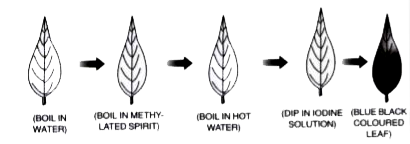Presence of hair on the leaf surface
Reduces transpiration
Increases transpiration
Helps in repid exchange of gases
Pervents guttation
The correct Answer is:A
Step-by-Step Solution:
1. Understanding the Question: The question asks about the effect of hair on the leaf surface. We need to analyze how these hairs (trichomes) influence transpiration and other processes.
2. Identifying the Options:
- a. Reduce transpiration
- b. Increase transpiration
- c. Helps in rapid exchange of gases
- d. Prevents curtation
3. Analyzing the Role of Leaf Hairs:
- Leaf hairs, or trichomes, are small outgrowths on the epidermis of leaves.
- They can create a microenvironment that reduces air movement around the leaf surface.
4. Effect on Transpiration:
- By reducing air movement, leaf hairs can decrease the rate of transpiration. This is because less wind means less evaporation of water from the leaf surface.
- Therefore, the presence of hairs acts as a windbreak, helping to retain moisture.
5. Evaluating Other Options:
- Option b (Increase transpiration): This is incorrect since the hairs reduce air movement, which in turn reduces transpiration.
- Option c (Helps in rapid exchange of gases): While some trichomes may aid in gas exchange, their primary role is not to facilitate rapid gas exchange.
- Option d (Prevents curtation): This option is not directly related to the function of leaf hairs.
6. Conclusion: Based on the analysis, the presence of hair on the leaf surface primarily serves to reduce transpiration.
Final Answer:
The correct answer is a. Reduce transpiration.
---
- a. Reduce transpiration
- b. Increase transpiration
- c. Helps in rapid exchange of gases
- d. Prevents curtation
- Leaf hairs, or trichomes, are small outgrowths on the epidermis of leaves.
- They can create a microenvironment that reduces air movement around the leaf surface.
- By reducing air movement, leaf hairs can decrease the rate of transpiration. This is because less wind means less evaporation of water from the leaf surface.
- Therefore, the presence of hairs acts as a windbreak, helping to retain moisture.
- Option b (Increase transpiration): This is incorrect since the hairs reduce air movement, which in turn reduces transpiration.
- Option c (Helps in rapid exchange of gases): While some trichomes may aid in gas exchange, their primary role is not to facilitate rapid gas exchange.
- Option d (Prevents curtation): This option is not directly related to the function of leaf hairs.
The correct answer is a. Reduce transpiration.
Topper's Solved these Questions
- TRANSPORT IN PLANTSBOOK - DINESH PUBLICATION ENGLISHCHAPTER - TRANSPORT IN PLANTSEXERCISE - REVISION QUESTIONS FROM COMPETITIVE EXAMS
425 Videos
- TRANSPORT IN PLANTSBOOK - DINESH PUBLICATION ENGLISHCHAPTER - TRANSPORT IN PLANTSEXERCISE - CHECK YOUR GRASP
40 Videos
- THE LIVING WORLDBOOK - DINESH PUBLICATION ENGLISHCHAPTER - THE LIVING WORLDEXERCISE - Check your grasp
12 Videos
- VERTEBRATA-AGNATHA AND PISCESBOOK - DINESH PUBLICATION ENGLISHCHAPTER - VERTEBRATA-AGNATHA AND PISCESEXERCISE - Check Your Grasp
12 Videos
Similar Questions
Presence of stomata on the under surface of dorsiventral leaf is a mechanism of
View SolutionTiny pores present on the leaf surface are called ______
View SolutionPresence of sheathing leaf base and ligule are characteristic of
View SolutionSilica incrustation is found on the leaf surface in
(a) Mango
(b) Grasses
(c) Castor
(d) Oleander
View SolutionA leaf with hair on its surface
View SolutionThe diagram below illustrates iodine test for the presence of starch in a leaf

Why is the leaf again boiled in hot water?
View SolutionThe diagram below illustrates iodine test for the presence of starch in a leaf

Why is the leaf boiled in water for few minutes ?
View SolutionThe diagram below illustrates iodine test for the presence of starch in a leaf

What is the composition of lodine solution in 100 mL of water?
View SolutionThe cause of special flavour in onion and garlic is due to the presence of
Or
Yellowing of tea leaf takes place by the deficiency of
View SolutionPores present on leaf surface for gaseous exchange
View Solution
